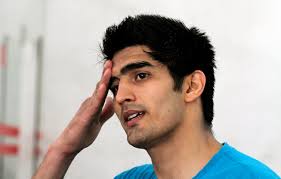 Fatehgarh Sahib/Chandigarh, Mar 12: Beijing Olympic bronze medalist Vijender Singh was questioned for five hours by the police at Panchkula Police Lines on Monday in connection with the recovery of 26 kg of heroin worth Rs 130 crore last week. Asked by a team comprising both Punjab and Haryana police for his hair and blood samples, Vijender refused saying he would find it humiliating.
Fatehgarh Sahib/Chandigarh, Mar 12: Beijing Olympic bronze medalist Vijender Singh was questioned for five hours by the police at Panchkula Police Lines on Monday in connection with the recovery of 26 kg of heroin worth Rs 130 crore last week. Asked by a team comprising both Punjab and Haryana police for his hair and blood samples, Vijender refused saying he would find it humiliating.
"I am not going to do this because I haven't taken the drug and giving the samples would be insulting to me," Vijender said, according to Punjab police DGP Sumedh Singh Saini.
Incidentally, substance detection period by hair tests confirms that drugs like heroin and morphine tend to lie down on the hair shaft and if the hair sample is long enough, drug testers may be able to determine when the drug use occurred over a 90-day period. The police have already sent Vijender's sparring partner Ram Singh's hair and blood samples to Fatehgarh Sahib civil hospital for testing.
Asked about 50 phone calls made from his mobile phone to Anoop Singh Kahlon, the jailed NRI from Canada and alleged drug peddler, Vijender sounded evasive. "My fans must have used the phone," he replied, according to police sources. On being questioned what he meant, Vijender reportedly said, "It must have been people at NIS who admire my boxing."
Vijender was also asked about the recovery of his Ford Endeavour near the flat of prime accused Anoop Singh Kahlon, an NRI from Canada and alleged drug peddler, and also about the statement of his sparring partner Ram Singh that the two had taken small quantities of the drug as "food supplements". The police declined to make public Vijender's replies to these questions.
Vijender reached Chandigarh at 11.30 am on Monday from Gurgaon, after being summoned by Haryana Police. He reached Police Lines in Panchkula at four pm and was joined by investigators of Punjab Police around 4.45 pm. The questioning began around five pm and Vijender came out of the room for a short while around 7.30 pm to speak to someone on his mobile phone, before going back in. His quizzing continued until 10pm.
It's learnt that the Haryana police decided to call Vijender after Punjab Police also wrote to them, asking them to call their "drug-consumer DSP" to join investigation in connection with the Rs 130-crore drug haul in Mohali. "International boxing star and Haryana Police DSP Vijender Singh has been consuming drugs and the details of his involvement have been shared with you. The investigation with him would be done in Haryana with the three investigation officers of Punjab joining the probe," the letter read.
"Our list of corroborating evidence against Vijender is growing. His friend Ram Singh and drug lord Anoop Singh Kahlon have made long confessions to us. We have text messages and phone call records," said SSP Fatehgarh Sahib district, Hardyal Singh Mann. However, he ruled out Vijender's involvement in peddling.
Punjab Police sources also said at least two corporate lawyers representing Vijender had reached Fatehgarh Sahib on Sunday. "They said that if we need to communicate with Vijender, it has to be through them. We refused to entertain them," said Mann. He added that Ram Singh was showing withdrawal symptoms like insomnia and restlessness after his detention.
"He mentions heroin and then stops short of making a pressing demand for it. Ten times a day, he seeks glucose-like energy drinks, often keeping awake for long hours after midnight," said Mann.





Comments
Add new comment